|
 |
|
News 2009
December 17 2009.
One more e-book published
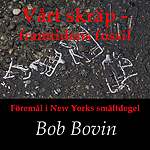
A second e-book, in Swedish, about the litter found in the bitumen of the New York streets is published and
can be found in the net-book stores. About 400 000 000 years from now the litter may be found as a fossil.
Have a look here
December 8 2009.
Save trees - read books without paper = e-books
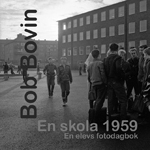
In good time for the exhibition of the school photos at the östgötlands länsmuseum the
28th of February 2010 we have published our first E-book. It is published in Swedish,
but you will find it is mostly a photo book; anyone will have fun with it regardless of language.
You can buy the book through any Swedish net book store and find more information
here
November 14 2009.
The exhibition at Mikaels church in Ryd, Linköping is now ended
The exhibiton had a lot of spectators according to the vicar Catharina Helmersson. Several persons from 1959 school
contacted me. My chemistry teacher, K-G Ahlström, gave me several names of persons on the pictures. You can find him on his home page
here
If you did not had time to see the exhibition in the church you can have a look at show
here.
You are all welcome to the exhibition at the östgötlands länsmuseum the 28th of February 2010.
October 18 2009.
One more week of the exhibition at Mikaels church in Ryd, Linköping
The vernissage had a lot of spectators because it was held after the service in
the church. I gave a short talk at the church coffee. Some students from other
counties were very interested to the old school of Sweden.
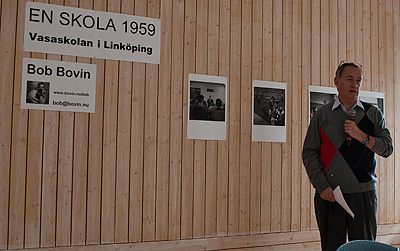
In the coffee room at Mikaels church
The news paper of the town, Corren, had an article about me and the exhibition.
The article can be read in Swedish here.
The local TV station, TV4, asked for recording of a reportage about the exhibition and a
visit to my old school, Vasaskolan. A young reporter and photographer, Hanna Kastner,
came and did a one and a half hour long recording. She was very skilled and did a
wonderful work. My wife took some photo of the interview.
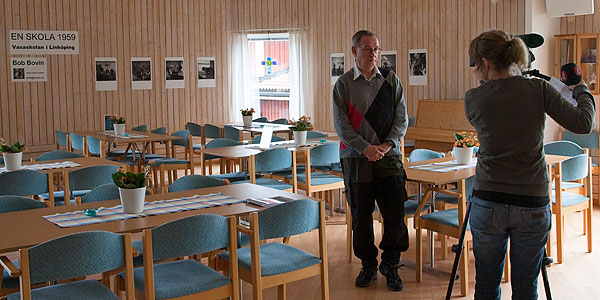
Hanna Kastner recording TV interview for TV4
We did a visit the my old school and a lot was different, but some looked like old days.
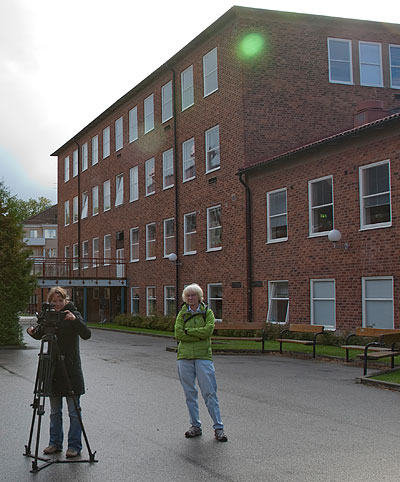
Hanna Kastner and Ingrid at Vasaskolan
The interview was broadcasted in the local news on Friday the 16th by TV4 Linköping and Norrköping.
It was sent three times during the day and you can see the whole interview by Hanna Kastner
here from the TV4 arcive.
September 24 2009.
Photo exhibition at the Mikaels church in Ryd, Linköping
Bob Bovin will show pictures taken 1959 at his school in Linköping. The school, named Vasaskolan, was a junior high school.
The exhibition starts at 27th of September at the church coffee and it goes on for a month.
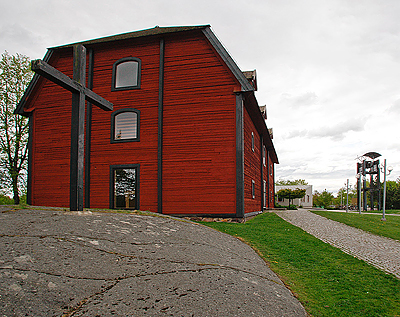
The Mikaels church at Ryd in Linköing, Sweden
All pictures are printed in black and white, 30x30 cm. You can take a look at the poster for the exhibition
here.
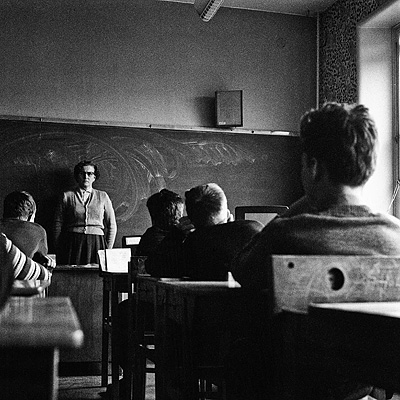

Teaching the 7th grade in 1959.
The Lucia celebration in winter time
June 25 2009.
A new Sun Halo seen in Lund
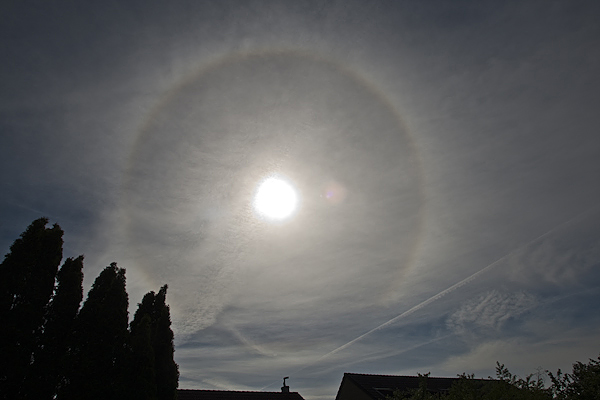 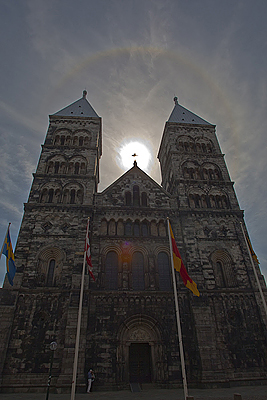
Clear sun halo at Lund
An other sun halo could be seen in Lund today. It was seen clear in the morning when colder weather came from south.
June 23 2009.
The life of an oriental poppy
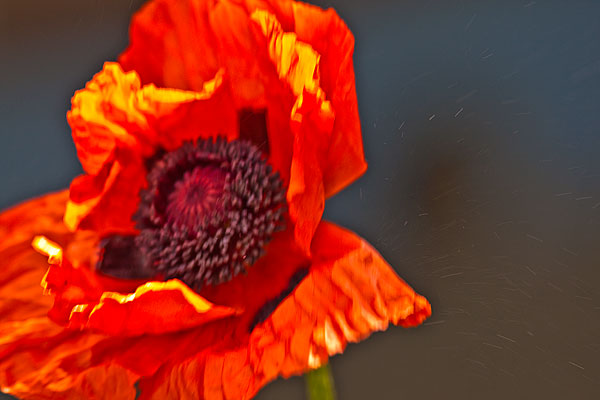
Poppy pollen spead in the wind
I have been following the short life of a single Oriental poppy (Papaver orientale) in our garden.
Photos from the opening of the bud to the drop of the petals could be seen
here.
The transport of the pollen by
the wind was recorded in the image above(magnified).
The speed of the pollen grains could be estimated, from the length of white lines and aperture speed, to be around 2 m/s.
Bumble bees transported the pollens away to the other flowers.
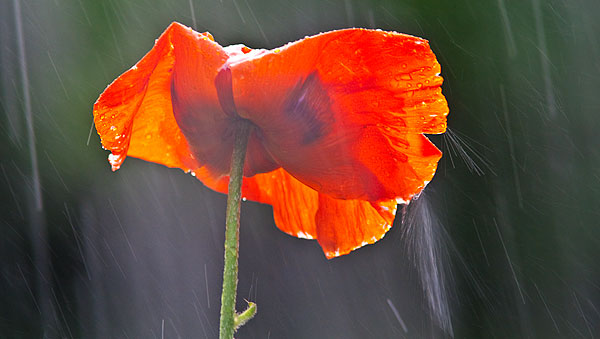
A rain- and hail storm beats the petals
Heavy rain and hail storms battered the flower
several times and finally end the beauty of the poppy. Next year we will place the seeds of this poppy in the soil to get a new beautiful poppy.
June 2 2009.
Sun Halo seen in Lund, Sweden at 12:45
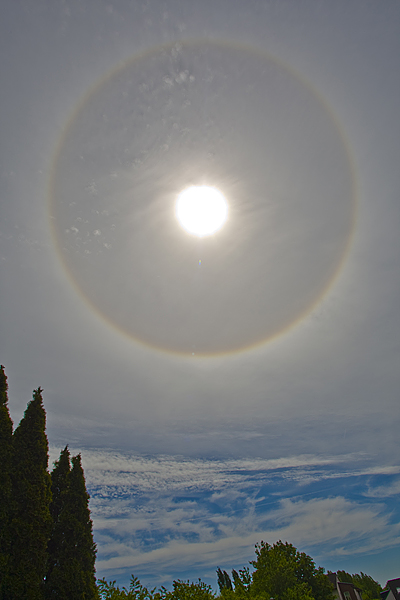
Sun Halo at Lund in Sweden. Time 12:45
A Sun halo can occur when the sun shine through high clouds like cirrostratus nebulosus. High clouds
can contain hexagonal ice crystals and when light refracts through these crystals a ring around the sun is
generated. In the halo mainly refraction occur, contrary to the rainbow, which include both refraction and
reflection phenomena.
The Sun halo exists only if the ice crystals are of the right size and geometry. Because the temperature
falls with about 6 C per kilometer up in the air the summer cloud must be at about 6 km the give the right
size, 0.05 mm to 0.5 mm, of small crystals. This is the right size to generate a fall down with the hexagonal
face down wards. When the crystals fall in this way the light will refract at a constant angle and the halo
will occur around the sun.
The spectrum around the sun is usually difficult to see clearly, but in the halo the red color is on the
inside of the halo and the blue color is on the outside (see the image below). This is the opposite to
the color spectra of the Rain bow as can also be seen in the image below.
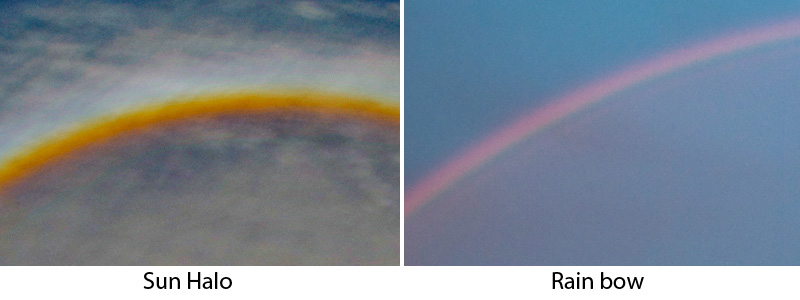
May 28 2009.
Wild life at Lat N 59o 48' 26" Lon E 15o 32' 56".
Green Hairstreak (Callophrys rubi)
Early summer life in the 2000 square meter of Tallsigen 5 in Riddarhyttan includes not only grandchildren's play,
but also the start of the summer wild life season. The pair of Pied Flycatcher (Ficedula hypoleuca) is working hard
to soften the bed for the eggs. The family of the Great tit (Parus major) already has eggs under the newly repaired
roof top of the old pig shed of the soon hundred years old home. The Eurasian red squirrel (Sciurus vulgaris) is
fantastic to balance on the fence on his way for more food in the nearby forest. Our permanent inhabitant, the
Robin (Erithacus rubecula), has a nest in one of our Norway Spruce (Picea abies) trees and works hard in the wind
to get food for the family.
In the wild garden there are plenty of Bilberry (Vaccinium myrtillus) plants in full bloom. Our resident,
they live under roof of the house, bumblebees (Bombus) fly around with heavy yellow legs to collect nectar from
all the Bilberry flowers. The butterflies start fly around on looking for the flowers. For the first time I used
a long telephoto lens 300 mm and a 2x-extender to photograph the insects. One of the butterflies was the almost
white Green-veined White (Pieris napi), very beautiful from the side and showing a strange structure in the eyes.
One of the more spectacular butterflies in the garden is a green blue, about 1 cm small, which could be identified as the
Green Hairstreak (Callophrys rubi). It lives among bilberries until the month of June.
Please take a look at the photos here.
May 25 2009.
Bob got selected at Canon Editor's Choice.
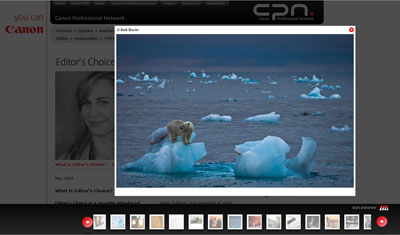
Aidan Sullivan, vice president of photo assignments for Getty Images, has reviewed the 4,314 photos
(from 1,063 photographers) received in the first edition of Canon Editor's Choice. His favorite images are showcased here.
Bob was elected with his Global warming image from Svalbard.
Aidan is commenting on the image in his video film featured at the same
CPN page.
April 10 2009.
This years visit to Lake Hornborga gave interesting photos
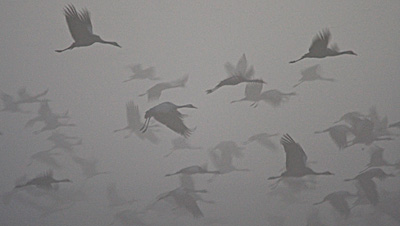
The first cranes fly in from the Lake Hornborga already before the sun is up. Later when the sun arrive in the sky there is a magical light
of yellowish, when the cranes start to dance and mate.
Please see some more images here.
January 25 2009.
Bob got elected member of PhotoNatura
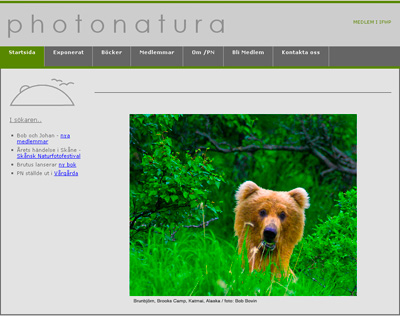
Front page of the PhotoNatura web-site
Bob just got elected as member of the PhotoNatura, an association of nature photographer in the south of Sweden. Please visit their home site here.
|
|